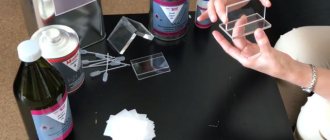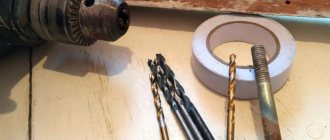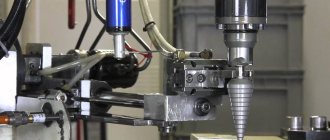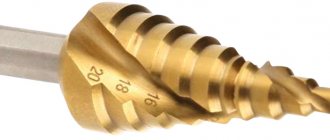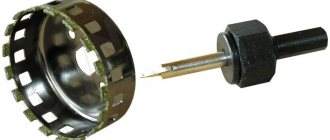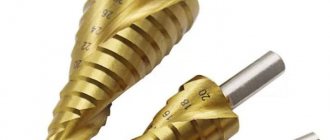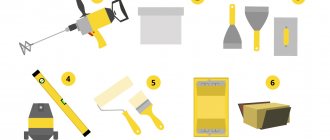When working with plexiglass, it is often necessary to drill it; we will tell you how and with what to drill plexiglass in this article. After reading a little about this process, you will understand that when drilling, the drill will be pulled into the material. What should you do to carefully drill through plexiglass and what exactly should you use to drill into this material?
Drilling of this material is carried out using a stationary drilling machine and a mobile drill; the drills used are those designed to work with light metals, high-speed steel, and also drills for hardened steel or carbide. It is possible to use drills of a canonical shape and a standard shape, and the sharpening angle should be in the range from 60° to 90°.
In order to get the best result when drilling plexiglass, it is necessary that the drill used meets certain technical requirements, namely:
- The elevation angle of the groove should be 17°;
- Drill point angle 70°;
- The rake angle should be sharpened to 3°...8°;
- The rear sharpening angle ranges from 0° to 4°.
The thinner the plexiglass, the smaller the sharpening angle at the apex should be. If the drill meets the parameters described above, then it will work properly, it will not drill the material, but scrape, this will prevent chipping.
To prevent overheating of the plexiglass, as well as to prevent the drill from becoming clogged with chips, it is necessary to periodically lift it and clean it. If as a result of your work you want to get a smooth surface of the hole, then you will need to do a little practice beforehand to find the optimal combination between the cutting speed and the speed at which you will feed the tool.
Cooling is of great importance, especially if work is carried out with material whose thickness is more than 5 mm. It is also necessary during the drilling process to lubricate with an emulsion intended for drilling, just pay attention to whether they are compatible with plexiglass.
How to drill plexiglass?
When working with plexiglass, it is often necessary to drill it; we will tell you how and with what to drill plexiglass in this article.
After reading a little about this process, you will understand that when drilling, the drill will be pulled into the material. What should you do to carefully drill through plexiglass and what exactly should you use to drill into this material? Drilling of this material is carried out using a stationary drilling machine and a mobile drill; the drills used are those designed to work with light metals, high-speed steel, and also drills for hardened steel or carbide. It is possible to use drills of a canonical shape and a standard shape, and the sharpening angle should be in the range from 60° to 90°.
In order to get the best result when drilling plexiglass, it is necessary that the drill used meets certain technical requirements, namely:
The thinner the plexiglass, the smaller the sharpening angle at the apex should be. If the drill meets the parameters described above, then it will work properly, it will not drill the material, but scrape, this will prevent chipping.
To prevent overheating of the plexiglass, as well as to prevent the drill from becoming clogged with chips, it is necessary to periodically lift it and clean it. If as a result of your work you want to get a smooth surface of the hole, then you will need to do a little practice beforehand to find the optimal combination between the cutting speed and the speed at which you will feed the tool.
Cooling is of great importance, especially if work is carried out with material whose thickness is more than 5 mm. It is also necessary during the drilling process to lubricate with an emulsion intended for drilling, just pay attention to whether they are compatible with plexiglass.
A convenient way to transform plexiglass is turning
Processing of plexiglass can be carried out in various ways, since it has properties that allow it to be considered a universal material.
When any processing of this material, an extremely important rule must be observed - the stress on the plexiglass must be moderate, it must not be overheated, otherwise cracks and breaks will form. Let's consider turning organic glass - for this they use a lathe, as for wood
Metal cutting machines can also be used. Turning is reminiscent of drilling, during which the part moves, and not the drill, as we are used to
Let's consider turning organic glass - for this they use a lathe, as for wood. Metal cutting machines can also be used. Turning is reminiscent of drilling, during which the part moves, and not the drill, as we are used to.
It is important that processing occurs at a very high speed. It is necessary to observe certain parameters - spindle speed and cutter feed - then you will get high quality products, no worse than their metal counterparts
After turning, the product can be polished. This method of giving plexiglass certain shapes is not as popular as for metal, but if we are talking about dielectrics or you need to use transparent material, then turning plexiglass becomes indispensable.
During the turning process, it becomes necessary to cool the plexiglass with purified water or a 2% solution of cutting fluid.
The processing of plexiglass with lathes should be carried out in accordance with the rule of thumb: the speed is 10 times higher than when processing steel. It is quite simple to check the fulfillment of this rule - a continuous flow of chips should be observed, and this also proves the correct turning angle of the tool.
The radius of the cutting edge of the tool must be at least 0.5 mm. To obtain a fine finish, you need to use tools with rounded cutters, saw at high speed, but at low feed rates and a minimum cutting depth.
Plexiglas, which has the shape of rods or circles with different diameters, is quite difficult to purchase. You may encounter the following problem: the cost of a blank in the form of a circle is an order of magnitude higher than the cost of sheet plexiglass. It is for this reason that circles and rods obtained as a result of processing sheet workpieces are more often found on sale.
The grain direction of extruded round stock and sheet/block stock are different. It is more advisable to choose extruded polycarbonate blanks, which are easy to buy in a store. You can choose a blank of the appropriate size with the required technical characteristics; in addition, it is advantageous to use polycarbonate rods instead of plexiglass.
When roughing, you can use carbide turning tools with a cutting depth of up to 6 mm. If finer processing is required, then tool steel cutters will be needed. Cutting speed and feed rate directly affect the resulting surface.
It can be cooled using emulsion for drilling or emulsion oils, which can be combined with acrylic. To obtain an ideal glossy surface, processing must be carried out on high-precision lathes using carefully polished diamond tools.
In such cases, a higher cutting speed is allowed than when working with other turning tools. The material should not be cooled to avoid the formation of optical defects.
In order to remove burrs, you can use new files and thin rasps, triangular and regular scrapers. This can also be done on longitudinal planing machines, which are used for processing wood.
Sharpening and processing should be carried out as follows: clearance angle 5-10°, rake angle 0-4°, cutting edge angle 45°, cutting speed 20-300 m/min, feed 0.1 to 0.5 mm/ turnover, cutting depth up to 6 mm.
It is important to check that all tools required for processing are sharpened and have the correct geometry. Otherwise, excess stress will arise, which means the part may crack during processing or during its operation.
The result of the processing performed depends entirely on whether you follow all the rules and ensure compliance with the required parameters.
Holes in plexiglass. How and what to do?
Plexiglas is a durable material, but at the same time malleable to all types of mechanical processing. It can be cut, drilled, polished and milled - with the right approach, damage to the plexiglass is excluded. But the most difficult procedure is drilling plexiglass - and many would like to know how to drill plexiglass without cracks and do it at home. There are many nuances in this procedure: from selecting the optimal drill to choosing the optimal speed when drilling.
How to glue?
To achieve strong adhesion and transparent seams, it is recommended to use solvent-based adhesive. When working with this glue, make sure that the room is well ventilated and away from sources of heat and fire. Also, follow the manufacturer's instructions and be sure to wear safety glasses and protective clothing.
The capillary method of gluing acrylic is the most popular. To achieve perfect bonding, check that the surfaces of the elements are well connected and are flat, straight and clean. Connect the parts using adhesive tape or a clamp, and keep the connection horizontal so that the glue does not leak out.
Carefully apply glue along the edges. When gluing edges that form a square corner, apply glue to the inside edge. When gluing flat edges, apply glue to both sides if possible.
For best results, use a bottle with a needle applicator. It will take at least 30 minutes for the parts to stick together, but to achieve maximum strength - from 24 to 48 hours.
Methods for drilling plexiglass
Regardless of the type of tool and equipment chosen, as well as the thickness of the acrylic sheet, you can drill plexiglass in only one way: by systematically immersing the working part of the drill into the sheet. But depending on the thickness of the plexiglass and the diameter of the required hole, the work can be done either in one pass or in several.
Let's take a closer look at how to make holes in plexiglass:
In order for holes in plexiglass to have perfectly smooth edges, it is necessary to achieve an ideal combination of the rotation speed of the drill and the depth of its penetration into the sheet. Insufficient speed leads to acrylic melting in the drilling zone, and too high speed leads to the appearance of torn sharp edges. To correctly make a hole in plexiglass, it is important to follow a certain sequence:
This will allow you to make a hole in plexiglass at home, while avoiding the appearance of chips and cracks in the material processing area.
How to cut?
Plexiglas is usually protected with film on both sides. It is recommended to leave the acrylic in a protective film throughout the processing process to protect the finish.
There are several ways to cut plexiglass, but regardless of the method you use, you must always ensure that the cutting tool does not cause heat to the material. One method of cutting is to use a cut-off machine, preferably with a 10-tooth-per-inch carbide blade. Plex can also be cut using a CNR milling machine, carbon dioxide (CO2) laser technology or a thin supersonic water jet. Please note that the edge finish will vary depending on the cutting method.
Choose a machine blade that is specifically designed for cutting acrylic. The teeth of the blade should be smooth, thin and evenly distributed at the same height. Make sure that the blade contacts the material at a constant speed, as changes in speed can cause the edge of the material to melt.
Thin pieces of acrylic (1/8 inch ≈ 3mm thick or less) can be cut like glass using an engraving knife, metal scriber, awl or mounting knife and finally broken apart carefully. Please note that if you need to make a long cut, this method will not work, as it leaves edges that are not flat enough, which are then difficult to glue.
Helpful tips for drilling
It is important to understand that organic glass belongs to the category of thermoplastic materials. And when heated to a temperature of 150–160 degrees, it begins to melt and deform.
To drill a hole in plexiglass efficiently and the first time, use a number of tips that can often be heard from professionals on specialized forums:
We also suggest watching an introductory video that tells you how to drill plexiglass using conventional metal equipment.
As you can see, acrylic lends itself well to all types of processing, and if certain nuances are observed, you can do literally anything with the material.
Source
Types of processing
Before talking about how exactly organic glass can be processed at home, you need to learn about the main types of such processes. If we talk about, in general, all possible options, the list will be as follows:
- cutting;
- milling;
- grinding;
- processing of plexiglass using pumice;
- stamping;
- getting the fold;
- turning work.
Such material, regardless of the specific type (this also applies to acrylic glass, of course, and made from polyvinyl chloride), is recognized as a type of thermoplastic plastic. When temperatures rise, even just to 150 degrees, there is inevitably an increased risk of deformation. Therefore, drilling organic glass is considered a much more complex operation than polishing, milling or cutting to size. To properly drill a hole, either CNC or manually, you need to carefully select the correct drill bit size.
Attention should also be paid to the brand of the drilling device.
In any case, it must be taken into account that organic glass compared to ordinary glass:
- twice as light;
- stronger;
- endures blows more steadfastly;
- optimally protects against heat spread;
- much more transparent.
Drilling tools
You can drill plexiglass using two tools to choose from:
When using a drill, it is important not to use the “impact” mode, which is only necessary for working with stone or concrete. As for the rotation speed of the drill, the optimal mode is from 500 to 1000 revolutions. The same settings can be used when working on drilling machines. Experts recommend using drills with a power of at least 750 W, optimally from 1200 W.
For high-quality drilling of plexiglass, you should use a drill with more than 750W power
Drill selection
For drilling thin sheets (up to 3 mm in diameter), ordinary steel metal drills can be used. They are not suitable for wood and concrete, since the former have an obtuse sharpening angle, while the latter have a pobedite tip. Feather ones are also not used - they leave large burrs.
Conventional metal drills can be used if the diameter of the final hole is up to 5 mm. In other situations, it is better to use special drills for plexiglass, which are made from high-speed steel. Their peculiarity is the sharpening angle. It should be selected according to the following scheme:
Exact adherence to the angle is not necessary, but it is better to avoid significant deviations in order to prevent damage to the material being processed.
Operating instructions
Using the correct tool does not guarantee that the hole will be straight and smooth. It is also necessary to follow basic drilling rules so as not to melt the edges or get deep burrs, which subsequently cause cracks to appear.
Drilling techniques
Conventionally, two drilling techniques can be divided:
- for holes with a diameter of less than 5 mm;
- for holes with a diameter of more than 5 mm.
Small holes are drilled at minimum speed, gradually increasing them up to 1000. The best option is to adjust the rotation speed from 500 to 1000 using reverse (accordingly, it is better to use drills that support this function). In this case, you should not drill for more than 10–15 seconds in one approach, taking a subsequent break for at least 10–20 seconds. This will prevent the edges of the hole from melting due to overheating. It is worth considering that increasing the temperature above 120–150 °C will also lead to darkening of the sheet material.
You should gradually increase the radius of the hole in the plexiglass, otherwise it may crack
To drill holes with a diameter of more than 5 mm, it is recommended to start with small-diameter drills, gradually increasing them in increments of 2-3 mm. This will prevent overheating and will also allow you to drill without putting pressure on the plexiglass itself. In addition, you can use water cooling, that is, supply water to the drilling head through a dropper or syringe (many machines have such a cooling system initially).
It is also important to perform drilling on a completely flat and smooth surface. Wood is ideal for this - it is inferior in hardness to plexiglass, so it will not be able to scratch it. It is better to take plywood or several layers of fiberboard or chipboard.
Step-by-step instruction
In most cases, the drilling process is performed according to the following scheme:
- Prepare the surface on which the plexiglass sheet will be located. It is optimal to use plywood, a wooden panel, or a pallet for this.
- Place a sheet of plexiglass. It is recommended that the place where drilling is not performed be covered with geotextile or any other fabric, which will protect the material from polymer and metal filings, which could theoretically scratch it.
Before drilling plexiglass, it is important to prepare the work area well to avoid damage to the material. - Install a compatible drill bit into the drill, select low speed, drilling mode (no impact).
- Start drilling at low speed. After a minimum recess appears, raise the speed to medium and in this mode drill up to ⅔ of the thickness of the material. Next, raise the speed to maximum, periodically reducing it to minimum to avoid overheating.
If the edges of the hole have melted, it is recommended to use a drill of a slightly larger diameter, but this will prevent overheating of the plexiglass. If burrs appear, you can get rid of them using a mineral stone drill (used primarily in drills for drilling). Naturally, the speed is maintained at a minimum.
Under no circumstances should you put pressure on the material itself - with heating and static pressure there is a possibility of its point deformation. Plexiglas will not suffer from this, will not become fragile, but will lose its original appearance.
Drills and screwdrivers are not suitable for drilling plexiglass due to the low speed.
So, in most cases, you can drill plexiglass using a regular household drill. Drill screwdrivers are not suitable due to the low number of revolutions (if they are used, burrs are formed, and considerable pressure must be applied).
The main thing is to choose the right drill, taking into account the thickness of the material and the diameter of the required hole, and also to prevent it from overheating during the process of drilling plexiglass. To produce large holes (over 10 mm with a thickness of more than 7 mm), it is recommended to use stationary machines with a drill water cooling system.
Drilling plexiglass - description
Plexiglas of any kind - PVC, acrylic, belongs to thermoplastic plastics. When the temperature increases, within small limits - up to 150–160 C, the material begins to melt and deform. This feature represents the biggest difficulty when working with a drill.
There are several rules to obtain the desired result:
Drilling tools?
Metal drills and wood drills are used. To hole a sheet 4–5 mm thick, a standard high-speed steel tool is used. For large diameter holes or when working with thick materials, tools made of hardened steel or carbide are used .
An important factor when selecting a drill is the sharpening angle. If the drill is not sharp enough, it will create too much friction: the material will begin to melt and wrap around the tip. If the sharpening angle is too sharp, the drill is pulled into the sheet: the material splits or forms microcracks inside the product.
Required parameters include:

